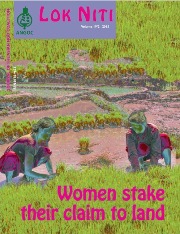This paper reviews the available data on men’s and women’s land rights, identifies what can and cannot be measured by these data, and uses these measures to assess the gaps in the land rights of women and men. Building on the conceptual framework developed in 2014 by Doss et al., we utilize…
This publication is a collection of 2014 CSO land reform monitoring reports on the status of land tenure and access to land from seven Asian countries (Bangladesh, Cambodia, India, Indonesia, Nepal, Pakistan, and the Philippines). The book also reflects the recent expansion of the monitoring…
This issue brief highlights the challenges indigenous peoples experience in securing their customary land rights in Bangladesh, Cambodia, India, Indonesia, Pakistan, and Philippines; hence, this publication specifies recommendations for the government and CSOs in strengthening the recognition to…
This issue brief highlights the challenges women are facing on access to lands, and the strategies in achieving gender justice for land rights - based from the results of the scoping studies on women and land in seven Asian countries (Bangladesh, Cambodia, India, Indonesia, Nepal, Pakistan, and…
This compilation of scoping studies on indigenous peoples in Bangladesh, Cambodia, India, Indonesia, Pakistan, and Philippines reveals how the basic bond of indigenous peoples to land are threatened by forces far more powerful than they are equipped to face.
This publication is a collection of scoping studies on women and land in Bangladesh, Cambodia, India, Indonesia, Nepal, Pakistan, and Philippines. It outlines the statuses of women's land rights in each country, the legal frameworks covering such rights, the key factors promoting or…
Using a participatory rural appraisal approach, a series of qualitative studies were conducted in four countries facing negative impacts of climate change—Bangladesh, Ethiopia, Kenya and Mali—in order to determine men’s and women’s perceptions of climate change, adaptive approaches, and the…
Food aid is a critical component of the global food system, particularly when emergency situations arise. For the first time, we evaluate the water footprint of food aid. To do this, we draw on food aid data from theWorld Food Programme and virtual water content estimates from WaterStat. We find…












